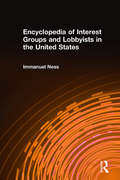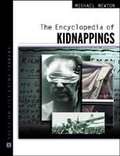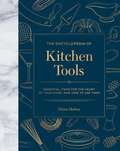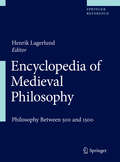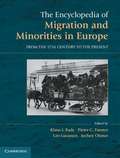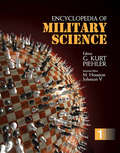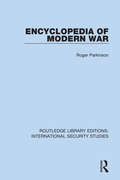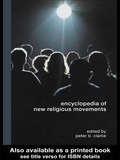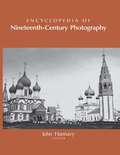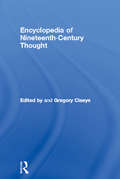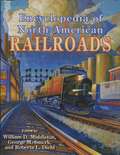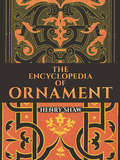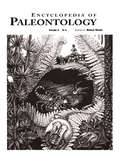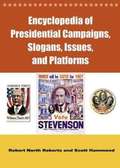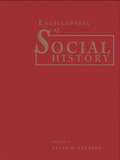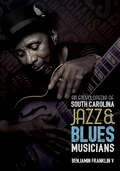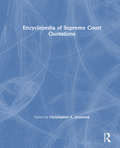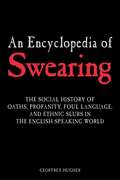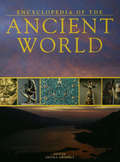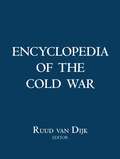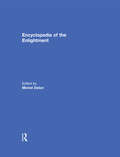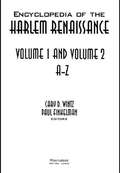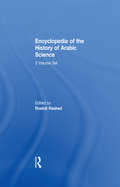- Table View
- List View
Encyclopedia of Interest Groups and Lobbyists in the United States
by Immanuel NessA comprehensive general reference on major American interest groups. This encyclopedia provides information on the lobbies and interest groups that dominate modern American politics. It provides descriptions of 13 categories of groups, followed by A-Z entries on the groups within that category.
The Encyclopedia of Kidnappings
by Michael NewtonAn A-to-Z encyclopedia of kidnappings that have taken place throughout history, from Viking raids and Aztec sacrifices to modern-day political kidnappings. Alphabetically arranged by subject, organization, and victims' and kidnappers' names, the volume contains nearly 1,000 entries.
The Encyclopedia of Kitchen Tools: Essential Items for the Heart of Your Home, And How to Use Them
by Elinor HuttonThe ultimate reference book for home cooks, seasoned chefs, and everyone in between, The Encyclopedia of Kitchen Tools guides readers through the history, practical uses, design features, and storage and maintenance requirements of each of the tools living in their kitchen cabinets. Whether you're a home cook pondering the difference between a cookie sheet and a baking pan (one of life's great questions), or a professional chef wondering whether you should sharpen your knives with a whetstone, a honing rod, or an electric sharpener, The Encyclopedia of Kitchen Tools has the answers you're looking for. Ranging from knives and spatulas, ladles and tongs, to Dutch ovens and crock pots, citrus reamers and zesters, The Encyclopedia of Kitchen Tools offers you a chance to reconsider all of the kitchen accessories you've accumulated over the years, as well as the opportunity to encounter some new tools for the first time.With additional sidebars discussing a wide variety of topics including the history of elaborate table settings, the best types of cocktail strainers (yes, there's more than one), the cleanliness of salt pigs, and the best ways to care for cast iron, The Encyclopedia of Kitchen Tools is the new, must-have reference bible for active cooks and armchair chefs alike.
Encyclopedia of Medical Immunology
by Ian R. Mackay Noel R. Rose Betty Diamond Anne DavidsonDifferent from other resources, this volume offers a broad appeal to microbiologists, immunologists, and infectious disease specialists on Autoimmune Diseases. The volume covers topics such as skin and alopecia, Kidney, Liver, Paraneoplastic, Resolution of inflammation, Cardiovascular/systemic inflammation and atherosclerosis, Gut, Regulatory lymphocytes T, B, other and Rheumatic Disease. The volume is written by internationally renowned authors who are authorities in their respective fields.
Encyclopedia of Medieval Philosophy
by Henrik LagerlundResearch on medieval philosophy has advanced greatly in the last thirty years, but there has not been a comprehensive encyclopedia summarizing the current research available. This two-volume reference work fills that void. The Encyclopedia of Medieval Philosophy covers all areas of philosophy in the Middle Ages and part of the Renaissance, ranging from 500 to 1500 CE. It contains general entries on medieval philosophers and medieval philosophies and on the key terms and concepts in the subject area, but it also provides more in-depth details and analyses of particular theories. Furthermore, in order to gain an insight into the social and cultural context of the material, entries are included on the teaching of philosophy, the career of philosophers, and the place of philosophy within the universities. Complete with cross-references between key words and related essays to enable efficient searches, this Encyclopedia is exhaustive, unprecedented, and user-friendly. It is indispensable for scholars of medieval philosophy and of the history of ideas, and it is also useful for anyone interested in medieval ideas and thought.
The Encyclopedia of Migration and Minorities in Europe
by Klaus J. Bade Pieter C. Emmer Leo Lucassen Jochen Oltmer Marlou Schrover Michael Schubert Jutta Tiemeyer Corrie Van EijlAlthough migration and integration have become important concepts today as a result of globalization, migration movements, integration, and multiculturalism have always been part of the history of Europe. Few people realize how many ethnic groups participated in migration within Europe or into Europe and this ignorance has grave consequences for the social and political status of immigrants. Newly available to an English-speaking audience, this encyclopaedia presents a systematic overview of the existing scholarship regarding migration within and into Europe. The first section contains survey studies of the various regions and countries in Europe covering the last centuries. The second section presents information on about 220 individual groups of migrants from the Sephardic Jews emigration from Spain and Portugal in the sixteenth and seventeenth centuries to the present-day migration of old-age pensioners to the holiday villages in the sun. The first resource of its kind, The Encyclopaedia of Migration is a comprehensive and authoritative research tool.
Encyclopedia of Military Science
by G. Kurt PiehlerThe Encyclopedia of Military Science provides a comprehensive, ready-reference on the organization, traditions, training, purpose, and functions of today’s military. Entries in this four-volume work include coverage of the duties, responsibilities, and authority of military personnel and an understanding of strategies and tactics of the modern military and how they interface with political, social, legal, economic, and technological factors. A large component is devoted to issues of leadership, group dynamics, motivation, problem-solving, and decision making in the military context. Finally, this work also covers recent American military history since the end of the Cold War with a special emphasis on peacekeeping and peacemaking operations, the First Persian Gulf War, the events surrounding 9/11, and the wars in Afghanistan and Iraq and how the military has been changing in relation to these events. Click here to read an article on The Daily Beast by Encyclopedia editor G. Kurt Piehler, "Why Don't We Build Statues For Our War Heroes Anymore?"
Encyclopedia of Military Science
by G. Kurt PiehlerThe Encyclopedia of Military Science provides a comprehensive, ready-reference on the organization, traditions, training, purpose, and functions of today’s military. Entries in this four-volume work include coverage of the duties, responsibilities, and authority of military personnel and an understanding of strategies and tactics of the modern military and how they interface with political, social, legal, economic, and technological factors. A large component is devoted to issues of leadership, group dynamics, motivation, problem-solving, and decision making in the military context. Finally, this work also covers recent American military history since the end of the Cold War with a special emphasis on peacekeeping and peacemaking operations, the First Persian Gulf War, the events surrounding 9/11, and the wars in Afghanistan and Iraq and how the military has been changing in relation to these events. Click here to read an article on The Daily Beast by Encyclopedia editor G. Kurt Piehler, "Why Don't We Build Statues For Our War Heroes Anymore?"
Encyclopedia of Modern War (Routledge Library Editions: International Security Studies #5)
by Roger ParkinsonThis book, first published in 1977, presents a comprehensive survey of the upheavals experienced in warfare from 1793 to the end of the twentieth century, a period that saw many fundamental changes – from the Napoleonic wars to the advent of total war, guerrilla and nuclear warfare. It discusses in detail the main aspects of warfare – battles, weapons, and people. It concentrates equally on all three, not emphasising one aspect at the expense of the others, and allowing cross-references between them so as to fit them into the general pattern of development. Also included are other factors essential to an understanding of modern warfare, such as technological items, and conceptual entries such as basic strategy and tactics, and various military theories and principles.
Encyclopedia of New Religious Movements
by Peter B. ClarkeNew Religious Movements (NRMs) can involve vast numbers of followers and in many cases are radically changing the way people understand and practice religion and spirituality. Moreover, many are having a profound impact on the form and content of mainstream religion. The Encyclopedia of New Religious Movements provides uniquely global coverage of the phenomenon, with entries on over three-hundred movement from almost every country in the world. Coverage includes movements that derive from the major religions of the world and to neo-traditional movements, movements often overlooked in the study of NRMs. In addition to the coverage of particular movements there are also entries on topics, themes, key thinkers and key ideas, for example the New Age Movement, Neo-Paganism, New Religion and gender, NRMs and cyberspace, NRMs and the law, the Anti-Cult Movement, Swedenborg, Jung, Teilhard de Chardin, Lovelock, Gurdjieff, al-Banna, Qutb. The marked global approach and comprehensiveness of the encyclopedia enable an appreciation of the innovative energy of NRMs, of their extraordinary diversity, and the often surprising ways in which they can propagate geographically. The most ambitions publication of its sort, the Encyclopedia of New Religious Movements is a major addition to the reference literature for students and researchers of the field in religious studies and the social sciences. Entries are cross-referenced with short bibliographies for further reading. There is a full index.
Encyclopedia of Nineteenth-Century Photography
by John HannavyThe Encyclopedia of Nineteenth-Century Photography is the first comprehensive encyclopedia of world photography up to the beginning of the twentieth century. It sets out to be the standard, definitive reference work on the subject for years to come. Its coverage is global – an important ‘first’ in that authorities from all over the world have contributed their expertise and scholarship towards making this a truly comprehensive publication. The Encyclopedia presents new and ground-breaking research alongside accounts of the major established figures in the nineteenth century arena. Coverage includes all the key people, processes, equipment, movements, styles, debates and groupings which helped photography develop from being ‘a solution in search of a problem’ when first invented, to the essential communication tool, creative medium, and recorder of everyday life which it had become by the dawn of the twentieth century. The sheer breadth of coverage in the 1200 essays makes the Encyclopedia of Nineteenth-Century Photography an essential reference source for academics, students, researchers and libraries worldwide.
Encyclopedia of Nineteenth Century Thought
by Gregory ClaeysEncyclopedia of Nineteenth Century Thought provides essential information on, and a critical interpretation of, nineteenth-century thought and nineteenth-century thinkers. The project takes as its temporal boundary the period 1789 to 1914. Encyclopedia of Nineteenth Century Thought primarily covers social and political thinking, but key entries also survey science, religion, law, art, concepts of modernity, the body and health, and so on, and thereby take into account all of the key developments in the intellectual history of the period. The encyclopedia is alphabetically organized, and consists of:* principal entries, divided into ideas (4000 words) and persons (2500 words)* subsidiary entries of 1000 words, which are entirely biographical* informational entries of 500 words, which are also biographical.
Encyclopedia of North American Railroads
by William D. Middleton Roberta L. Diehl Rick MorganLavishly illustrated and a joy to read, this authoritative reference work on the North American continent's railroads covers the U.S., Canadian, Mexican, Central American, and Cuban systems. The encyclopedia's over-arching theme is the evolution of the railroad industry and the historical impact of its progress on the North American continent. This thoroughly researched work examines the various aspects of the industry's development: technology, operations, cultural impact, the evolution of public policy regarding the industry, and the structural functioning of modern railroads. More than 500 alphabetical entries cover a myriad of subjects, including numerous entries profiling the principal companies, suppliers, manufacturers, and individuals influencing the history of the rails. Extensive appendices provide data regarding weight, fuel, statistical trends, and more, as well as a list of 130 vital railroad books. Railfans will treasure this indispensable work.
The Encyclopedia of Ornament
by Henry ShawFirst published in 1842, this volume made an important contribution to the nineteenth-century Gothic Revival, during which English artists rediscovered decorative styles from their country's medieval past. Few published sources of the Victorian era offered information on historic designs, and The Encyclopedia of Ornament was warmly received and widely praised for the meticulous rendering of its plates. Modern-day graphic artists and designers, art historians, and students of the history of style and decoration will likewise prize this extensive treasury of authentic designs. Arranged in chronological order, this richly illustrated compilation traces a long history of ornamentation: ironwork of the thirteenth century; painted tiles of the thirteenth and fifteenth centuries; wood carvings and panels of the fifteenth and sixteenth centuries; fifteenth-century ornamental drapery; sixteenth-century book bindings; designs for jewelry, plate, and other decorative items by Hans Holbein and his contemporaries; lace and needlework of the seventeenth century; and architectural ornaments and stained glass of various periods from English and French cathedrals.
Encyclopedia of Paleontology
by Ronald SingerFirst Published in 2000. Routledge is an imprint of Taylor & Francis, an informa company.
Encyclopedia of Presidential Campaigns, Slogans, Issues, and Platforms
by Robert North Roberts Scott J. HammondAimed at college undergraduates and high school students, this reference covers the political history of presidential rhetoric and campaigns. The first part of the volume contains chronologically arranged entries describing the course and nature of each presidential campaign since 1789. The second part features longer, general entries discussing broader campaign issues (affirmative action, for example) as well as short entries that focus on a single slogan or phrase (such as "read my lips"). Annotation ©2004 Book News, Inc., Portland, OR (booknews.com)
Encyclopedia of Social History (Garland Reference Library Of Social Science Ser. #Vol. 780)
by Peter N. StearnsA reference surveying the major concerns, findings, and terms of social history. The coverage includes major categories within social history (family, demographic transition, multiculturalism, industrialization, nationalism); major aspects of life for which social history has provided a crucial per
An Encyclopedia of South Carolina Jazz & Blues Musicians
by Benjamin Franklin VThis comprehensive A-to-Z reference is “an impressive contribution to jazz history and surprisingly good reading” (Michael Ullman, author of Jazz Lives).This informative bookdocuments the careers of South Carolina jazz and blues musicians from the nineteenth century to the present. The musicians range from the renowned (James Brown, Dizzy Gillespie), to the notable (Freddie Green, Josh White), the largely forgotten (Fud Livingston, Josie Miles), the obscure (Lottie Frost Hightower, Horace “Spoons” Williams), and the unknown (Vince Arnold, Johnny Wilson).Though the term “jazz” is commonly understood, if difficult to define, “blues” has evolved over time to include R&B, doo-wop, and soul. Performers in these genres are also represented, as are members of the Jenkins Orphanage bands of Charleston. Also covered are nineteenth-century musicians who performed what might be called proto-jazz or proto-blues in string bands, medicine shows, vaudeville, and the like.Organized alphabetically, from Johnny Acey to Webster Young, the entries include basic biographical information, South Carolina residences, career details, compositions, recordings as leaders and as band members, films, awards, websites, and lists of resources for additional reading. Former host of Jazz in Retrospect on NPR Benjamin Franklin V has ensured biographical accuracy to the greatest degree possible by consulting numerous public documents, and information in these records permitted him to dispel myths and correct misinformation that have surrounded South Carolina’s musical history for generations.“Elucidates South Carolina as a profoundly crucial puzzle piece alongside New Orleans, Chicago, Kansas City and New York.” —Harry Skoler, professor, Berklee College of MusicIncludes photos
The Encyclopedia of Supreme Court Quotations
by Christopher A. AnzaloneA veritable feast of 1,500 quotes from more than 1,000 Supreme Court decisions, this is the first such reference devoted solely to the Supreme Court. Dating from the beginning of the Republic to the present, these excerpts provide a powerful historical overview of the mission and majesty of the Supreme Court. They are topically arranged and cover the legislative, judicial, and executive branches; states' rights; due process; free speech; equal rights; and freedom of religion.Each entry features the quote -- especially chosen for its profound, compelling, and inspirational nature; the name of the case, primary citation, year, and author; and the kind of decision (dissenting, concurring, or opinion of the Court).
An Encyclopedia of Swearing: The Social History of Oaths, Profanity, Foul Language, and Ethnic Slurs in the English-speaking World
by Geoffrey HughesThis is the only encyclopedia and social history of swearing and foul language in the English-speaking world. It covers the various social dynamics that generate swearing, foul language, and insults in the entire range of the English language. While the emphasis is on American and British English, the different major global varieties, such as Australian, Canadian, South African, and Caribbean English are also covered. A-Z entries cover the full range of swearing and foul language in English, including fascinating details on the history and origins of each term and the social context in which it found expression. Categories include blasphemy, obscenity, profanity, the categorization of women and races, and modal varieties, such as the ritual insults of Renaissance "flyting" and modern "sounding" or "playing the dozens." Entries cover the historical dimension of the language, from Anglo-Saxon heroic oaths and the surprising power of medieval profanity, to the strict censorship of the Renaissance and the vibrant, modern language of the streets. Social factors, such as stereotyping, xenophobia, and the dynamics of ethnic slurs, as well as age and gender differences in swearing are also addressed, along with the major taboo words and the complex and changing nature of religious, sexual, and racial taboos.
Encyclopedia of the Ancient World
by Shona GrimblyEncyclopedia of the Ancient World is a colorful and lively examination of some of the most important civilizations that have shaped our world. Each entry concentrates on a particular civilization, or series of civilizations, and combines its history with an explanation of who the people were and how they lived. An examination of respective belief systems and myths is also included. Reflecting the latest developments in archaeology and bio-geography, LEncyclopedia of the Ancient World explains how the ancient civilizations developed, and how they came to dominate their neighbors, how they evolved, and why they eventually declined or died out. Encyclopedia of the Ancient World also features 400 full-color and black-and-white photographs, as well as specially commissioned diagrams and reconstructions, that help to illuminate life as it was lived many centuries ago. The book concludes with an extensive time-line that places the civilizations in an historic context; a bibliography of suggested further reading; a glossary of useful terms; and a comprehensive index.
Encyclopedia of the Cold War
by Ruud Van DijkBetween 1945 and 1991, tension between the USA, its allies, and a group of nations led by the USSR, dominated world politics. This period was called the Cold War – a conflict that stopped short to a full-blown war. Benefiting from the recent research of newly open archives, the Encyclopedia of the Cold War discusses how this state of perpetual tensions arose, developed, and was resolved. This work examines the military, economic, diplomatic, and political evolution of the conflict as well as its impact on the different regions and cultures of the world. Using a unique geopolitical approach that will present Russian perspectives and others, the work covers all aspects of the Cold War, from communism to nuclear escalation and from UFOs to red diaper babies, highlighting its vast-ranging and lasting impact on international relations as well as on daily life. Although the work will focus on the 1945–1991 period, it will explore the roots of the conflict, starting with the formation of the Soviet state, and its legacy to the present day.
Encyclopedia of the Enlightenment
by Michel Delon Philip Stewart Gwen WellsThis acclaimed translation of Michel Delon's Dictionnaire Europen des Lumires contains more than 350 signed entries covering the art, economics, science, history, philosophy, and religion of the Enlightenment. Delon's team of more than 200 experts from around the world offers a unique perspective on the period, providing offering not only factual information but also critical opinions that give the reader a deeper level of understanding. An international team of translators, editors, and advisers, under the auspices of the French Ministry of Culture, has brought this collection of scholarship to the English-speaking world for the first time.
Encyclopedia of the Harlem Renaissance
by Cary D. Wintz Paul FinkelmanFrom the music of Louis Armstrong to the portraits by Beauford Delaney, the writings of Langston Hughes to the debut of the musical Show Boat, the Harlem Renaissance is one of the most significant developments in African-American history in the twentieth century. The Encyclopedia of the Harlem Renaissance, in two-volumes and over 635 entries, is the first comprehensive compilation of information on all aspects of this creative, dynamic period.For a full list of entries, contributors, and more, visit the Encyclopedi a of Harlem Renaissance website.
Encyclopedia of the History of Arabic Science: Volume 3 Technology, Alchemy and Life Sciences
by Roshdi RashedThe Arabic contribution is fundamental to the history of science, mathematics and technology, but until now no single publication has offered an up-to-date synthesis of knowledge in this area. In three fully-illustrated volumes the Encyclopedia of the History of Arabic Science documents the history and philosophy of Arabic science from the earliest times to the present day. The set as a whole covers seven centuries. Thirty chapters, written by an international team of specialists from Europe, America, the Middle East and Russia cover such areas as astronomy, mathematics, music, engineering, nautical science and scientific institutions.
